![]()
![]()
![]()
Use LEFT and RIGHT arrow keys to navigate between flashcards;
Use UP and DOWN arrow keys to flip the card;
H to show hint;
A reads text to speech;
42 Cards in this Set
- Front
- Back
|
What is one factor that greatly affects your stopping distance?
|
The best answer: Braking ability of your vehicle.
Comment: The faster you drive, the greater your stopping distance even in ideal conditions. Stopping distance can also depend on road and weather conditions, the weight of your vehicle, your reaction time, and the braking ability of your vehicle. |
|
|
When are you allowed to pass a school bus?
|
The best answer: If the school bus is in motion.
Comment: When the red lights flash, stop before reaching the bus and remain stopped until the driver turns off the flashing red lights. Under special circumstances, an officer may be directing the flow of traffic. If so, obey the officer's hand signals instead of the normal traffic signals or signs. |
|
|
A pedestrian has entered a crosswalk and should be given the right-of-way:
|
The best answer: In all situations.
Comment: Stop and remain stopped for a pedestrian crossing in a crosswalk when the pedestrian is:In your lane of travel,In a lane next to your lane of travel, including a bike lane, orIn the lane you are turning into. AND If you are turning at an intersection that has a traffic signal, before you begin to turn the pedestrian must be six feet or more from the lane you are turning into.If you are turning at an intersection that doesn't have a traffic signal, before you begin to turn the pedestrian must be past the lane you are turning into, plus the next lane. |
|
|
When leaving a parked or stopped position:
|
The best answer: Check your blind spots and mirrors, and yield to all other traffic.
Comment: When leaving a parked or stopped position, check your blind spots and mirrors, and yield to all other traffic. |
|
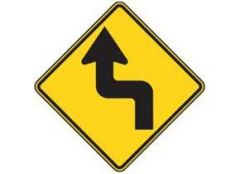
When you see this sign, what should you expect ahead?
|
The best answer:Two sharp turns.
Comment: Reverse turn. This sign tells you there is a sharp turn to left, and then right. |
|
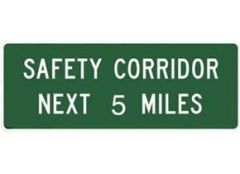
Safety corridors are stretches of highway:
|
The best answer: That have more fatal and severe injury crashes than the statewide average.
Comment: Safety corridors are designated stretches of highway with more fatal and severe injury crashes than the statewide average. Turn on your lights for safety. Signs identifying safety corridors may include diamond shaped flags. |
|
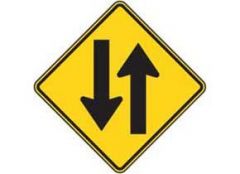
What does this sign mean?
|
The best answer: Two-way traffic.
Comment: Two-Way Traffic sign. The one-way street or roadway with a median or divider in the middle joins a two-way roadway ahead. You will then be facing oncoming traffic. The sign is also used along such a road. |
|
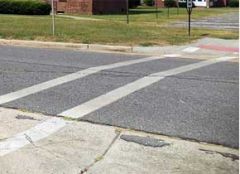
True or false? You are allowed to park on a crosswalk if you are more than 20 feet from an intersection.
|
The best answer: False, parking on a crosswalk is always illegal.
Comment: You cannot stop or park your vehicle on a sidewalk, crosswalk, bicycle lane or path. |
|
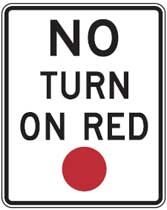
When you see this sign you must:
|
The best answer: Stop and wait for a green signal before turning.
Comment: You may not turn right or left during the red light where these signs are posted. You must wait for the signal to turn green. |
|

Maintaining a safe following distance from the vehicle in front of you:
|
The best answer: Gives you a better view of the road and more time to react.
Comment: Always maintain a safe following distance from the vehicle in front of you. You will have a better view of the road to watch for problems and more time to react. A safe following distance of 2-4 seconds does not mean you can stop within 2-4 seconds. |
|
|
If you are involved in a crash with another vehicle, you must always:
|
The best answer: Stop at the scene.
Comment: If you have a traffic crash, you must:Stop at the scene. If a person is killed or unconscious, remain at the scene of the crash until police arrive.Give reasonable assistance to injured persons. Injured people should never be moved carelessly.Exchange information.Under certain conditions, file an accident report within 72 hours. |
|
|
You may drink alcoholic beverages in a vehicle on a public highway:
|
The best answer: Under no circumstances.
Comment: Under Oregon's Open Container law, it is illegal to drink alcohol or have an open bottle or other container with alcohol in it while you are in a vehicle on any road. Any open bottles or containers should be in the trunk. |
|

Trying to beat a truck to a highway exit is dangerous because:
|
The best answer: Trucks take longer to stop.
Comment: Do not cut in front of a truck or bus. Otherwise, you remove the driver's cushion of safety. Remember, trucks and buses take longer to stop than small vehicles traveling at the same speed. |
|
|
To back your vehicle safely:
|
The best answer: Do not depend solely on your mirrors.
Comment: To see as much as possible, turn your body and head to the right and look out through the rear window. Do not depend on your mirrors. Mirrors do not give you a full view. |
|
|
When approaching a railroad crossing you should:
|
The best answer: Look, listen, and slow down.
Comment: When approaching a railroad crossing look, listen, and slow down because you may have to stop. |
|
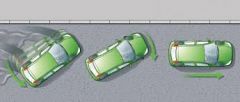
What is the main cause of car skids?
|
The best answer: Unsafe speed.
Comment: Driving too fast for conditions is the main cause of skids. |
|
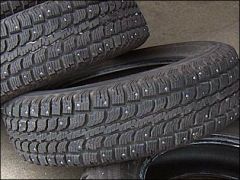
Studded tires are generally allowed in Oregon:
|
The best answer: From November 1 through March 31.
Comment: Studded tires are generally allowed in Oregon only from November 1 through March 31. Because of the damage caused by studded tires, they should only be used when necessary. Remember, some states ban the use of studded tires. |
|
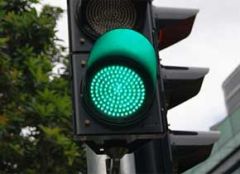
When a traffic signal turns green, you:
|
The best answer: May need to stop to avoid blocking the intersection.
Comment: A green signal means all movements are permitted, unless prohibited by a sign. Always yield to pedestrians, bicycles, and traffic in the intersection. Even if you have a green light, do not start across an intersection if it causes your vehicle to stop in the intersection and block other traffic or a pedestrian crosswalk. |
|
|
On a two-lane street your vehicle is being followed by a fire engine that is not using emergency signals. You should:
|
The best answer: Continue to drive in a normal manner.
Comment: When you hear the warning signal (siren, bell or horn) or see the warning lamps (flashing red or blue) of an emergency vehicle, you must provide a clear path for the emergency vehicle and stop. |
|
|
When entering a freeway, you should check traffic by:
|
The best answer: Using your mirrors and looking over your left shoulder.
Comment: While on the on-ramp you have a chance to observe traffic conditions on the freeway. Use your mirrors and check your blind spots before merging. |
|
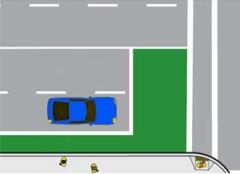
You are approaching this intersection where a red traffic signal is shown. You wish to turn. Where should you stop?
|
The best answer:At the first white line.
Comment: A bike box helps prevent collisions between motorists and bicycles at intersections. It is typically a painted box on the road with a white bicycle symbol inside. Bicycle lanes approaching and leaving the box may also be painted. As a driver, you must stop for a traffic signal behind the bike box. Do not stop in the box. Bicyclists will move into the box, in front of your vehicle or other traffic, at the intersection. No right turns are allowed at these intersections when the traffic signal is red. If turning right on a green light, you must signal and watch for bicyclists on the right. |
|
|
If you need to use hand and arm signals, how would you signal a right turn?
|
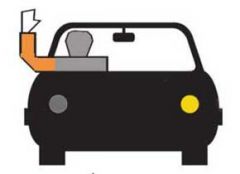
The best answer: Extend left arm, with elbow bent upward.
Comment: Right turn - left arm extended, with elbow bent upward, at about a 90-degree angle. |
|
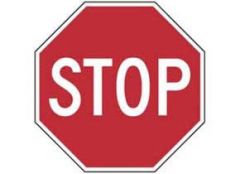
This sign means:
|
The best answer: Come to a complete stop and yield.
Comment: Octagon shape is used for stop signs. This sign means you must come to a complete stop. Yield to pedestrians and other vehicles. When it is safe, you may enter the intersection. Signs often use symbols or pictures rather than words. Each type of sign has a special color and shape to help you easily recognize the sign at a glance. |
|

Any time you turn on your wipers due to bad weather, you should also:
|
The best answer: Turn on your headlights.
Comment: Remember to turn on your headlights whenever you have trouble seeing others. If you have trouble seeing them, they may be having trouble seeing you. Increase your visibility to other motorists by turning on your headlights when your windshield wipers are on. |
|
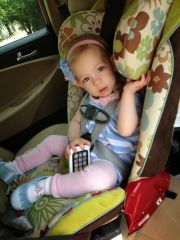
Children must ride rear-facing until they reach both:
|
The best answer: One year of age and 20 pounds.
Comment: Infants must ride rear-facing until they reach both one year of age and twenty pounds. |
|
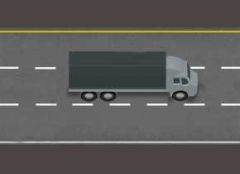
Large vehicles have:
|
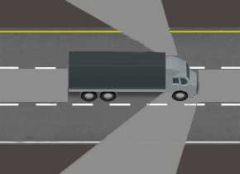
The best answer: Much larger blind spots than cars.
Comment: Even though trucks and buses have many mirrors, there are still areas around the vehicle which the driver has difficulty seeing. Some of these areas are impossible to see and are known as blind spots. The blind spots are generally larger than cars. They exist on both sides, to the rear and the front. |
|
|
When passing another vehicle on a two-lane road, you should pass:
|
The best answer: Only to the left of the vehicle.
Comment: When passing another vehicle on a two-lane road, you should pass only to the left of the vehicle. |
|
|
Why should you increase your following distance when following a large vehicle?
|
The best answer: To see and be seen.
Comment: The drivers of large vehicles may not be able to see you when you are directly behind them. These vehicles also block your view of the road ahead. |
|
|
Where should you stop at an intersection where there is a stop sign, but no stop line or crosswalk?
|
k |
|
|
When is it legal for a driver under 18 to use a cell phone while driving?
|
The best answer: When summoning medical or other emergency help.
Comment: It is illegal for drivers under 18 years of age to talk or text on a cell phone or other communication device while operating a vehicle. A cell phone may be used, regardless of age, when summoning medical or other emergency help if no other person in the vehicle is capable of summoning help. |
|
|
You are approaching a public transit bus from behind. When must you yield for the bus to re-enter traffic?
|
The best answer: When the bus has its turn signal and flashing yield sign on.
Comment: Public transit buses often pull to a curb to load or unload passengers. Vehicles approaching from the rear must yield when a bus driver signals to re-enter a traffic lane and there is an electric sign flashing yield on the back of the bus. |
|
|
To avoid being blinded by the headlights of an approaching car at night:
|
The best answer: Look to the right side of the road.
Comment: Look slightly to the right of oncoming lights and watch the road edge or fog line. This will help guard against headlight glare. |
|
|
Any time you cannot see persons or vehicles at a distance of 1,000 feet, you must:
|
The best answer: Turn on your headlights.
Comment: Headlights must be turned on from sunset to sunrise. Lights also must be on at any time conditions make it difficult to see people or vehicles 1,000 feet ahead. |
|
|
When being followed too closely (tailgated), you should:
|
The best answer: Move over to the right or slowly reduce your speed.
Comment: If a vehicle behind you is following too closely and there is a right lane, move over to the right. If you cannot move over, slowly reduce your speed. This may encourage the vehicle to pass you or to stop tailgating. Never brake hard to discourage tailgating - you could get hit from behind. |
|
|
If you are involved in a collision with another vehicle, you must:
|
If you have a traffic crash, you must:Stop at the scene. If a person is killed or unconscious, remain at the scene of the crash until police arrive.Give reasonable assistance to injured persons. Injured people should never be moved carelessly.Exchange information.Under certain conditions, file an accident report within 72 hours.
|
|
|
You drive defensively when you:
|
The best answer: Are aware of what is to the front, sides, and rear of your vehicle.
Comment: The key to being a safe and responsible driver is to be aware of your surroundings at all times and to be alert for potentially dangerous situations. You must be able to see what is to the front, sides, and rear of your vehicle. Do not load or equip your vehicle in any way that blocks what you can see. Placing stickers or other objects on your vehicle's windows can limit your view of the road. |
|
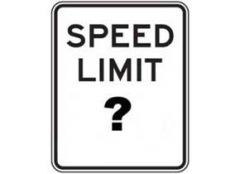
You are driving home from work on an interstate. When may you drive faster than the maximum speed limit?
|
The best answer: Never.
Comment: Always follow speed limits. You may be cited if you drive at a speed above the maximum speed limit or at a speed that is unreasonable or unwise given the existing conditions. An escort vehicle must accompany a funeral procession, and the escort may exceed the maximum speed limit by 10 miles per hour. |
|
|
For your driving experience to meet the requirements of a class C provisional license, your driving must have been supervised by someone at least:
|
The best answer: 21 years of age who had a license for three years or more.
Comment: For your driving experience to meet the requirement, it must have been supervised by someone at least 21 years of age who had a valid license for at least three years |
|
|
When you are tired or sleepy behind the wheel:
|
The best answer: You are slower to react.
Comment: When tired or sleepy, you are slower to react, likely to make poor decisions, and less aware of changing road and traffic conditions. Be sure you are alert and well rested before and during travel. |
|
|
When following an emergency vehicle using sirens and flashing red lights, you must:
|
The best answer: Stay at least 500 feet behind.
Comment: Follow no closer than 500 feet behind an emergency vehicle answering an alarm. |
|
|
You are driving at high speed when your accelerator pedal sticks. What should you do? |
The best answer: Shift to neutral (or depress the clutch).
Comment: If your accelerator sticks:Search for an escape path.Shift the vehicle to neutral. Use an open palm to avoid shifting into another gear.Steer smoothly while braking.Pull off the road when it is safe to do so. |
|
|
Always allow extra room in front of your vehicle when:
|
The best answer: Towing a trailer.
Comment: You should allow extra room when you have a heavy load or are pulling a trailer. The extra weight increases your stopping distance. |

